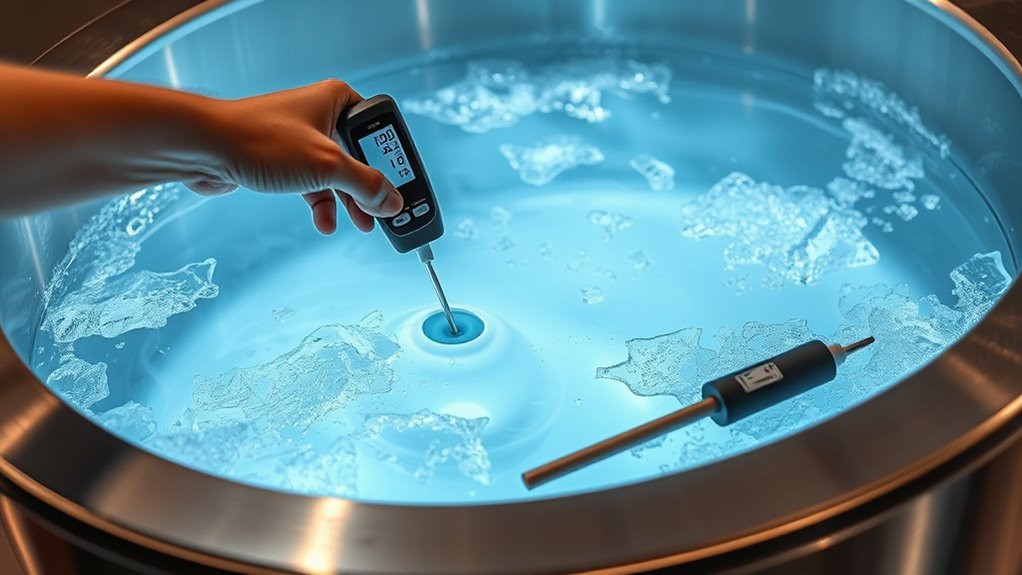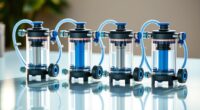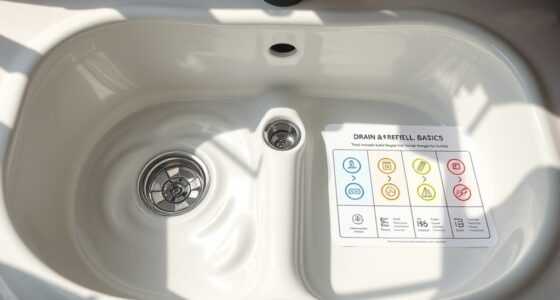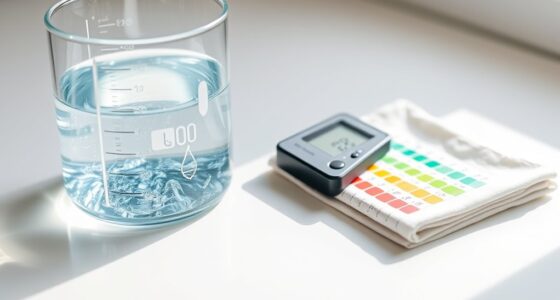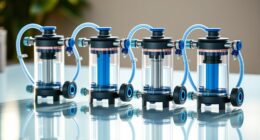To test your cold plunge tub’s pH levels, use reliable test strips or kits by dipping or filling a test vial and comparing the color to the chart; aim for a pH of 7.2 to 7.6. If the pH is too low, add a pH increaser carefully, and if it’s too high, use a pH reducer, adding chemicals gradually and rechecking after each step. Maintaining proper pH guarantees clean, safe water and longer equipment life—continue to learn the best tips for balanced water.
Key Takeaways
- Use a reliable test strip or kit to measure the current pH level of the water.
- Compare the test result to the ideal pH range of 7.2 to 7.6.
- Add pH increasers (sodium carbonate) if pH is below 7.2, or reducers (muriatic acid) if above 7.6.
- Add chemicals gradually, re-test after each adjustment to avoid overshooting.
- Monitor pH weekly and after water changes to maintain safe, comfortable, and hygienic water conditions.
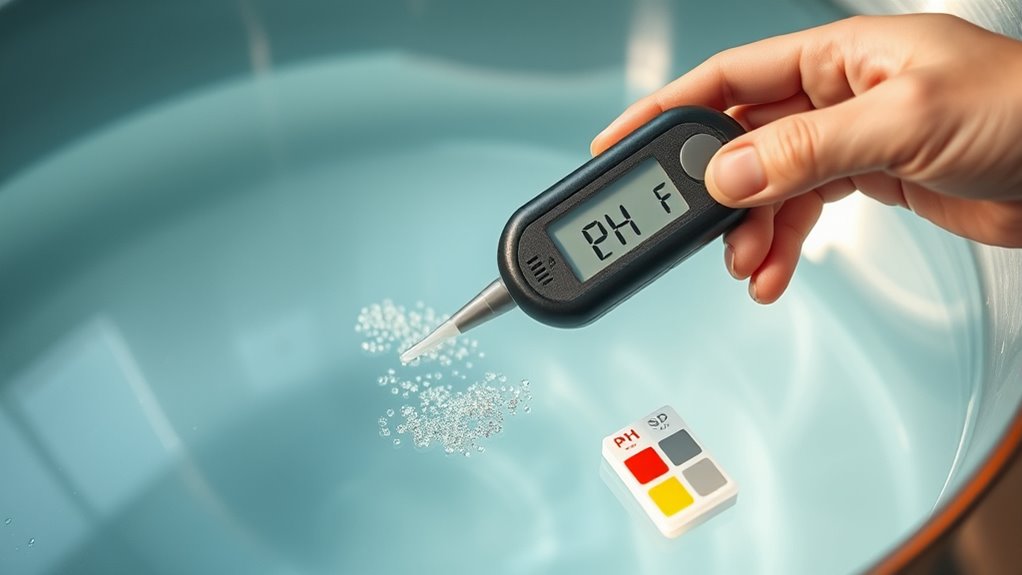
Maintaining proper pH levels in your cold plunge tub is essential for ensuring safe, clean, and comfortable water. When you keep the pH balanced, you help prevent issues like skin irritation, equipment corrosion, and bacteria growth. The key to effective pool maintenance involves regularly testing the water and making the right chemical adjustments to keep everything in check. This not only prolongs the lifespan of your tub but also guarantees a more enjoyable experience each time you plunge.
Start by testing the pH level using a reliable test kit or test strips designed specifically for pools or spas. These are straightforward to use: dip the strip into the water or fill the test vial, wait a few seconds, then compare the color change to the provided chart. Aim for a pH level between 7.2 and 7.6, which is ideal for comfort and safety. If the pH is too low, it indicates acidity, which can cause skin irritation and damage to your tub’s components. Conversely, a high pH can lead to cloudy water and mineral buildup.
Once you know the current pH level, you’ll need to perform chemical adjustments to bring it into the appropriate range. If the water is too acidic, add a pH increaser—commonly a sodium carbonate or soda ash—according to the product instructions. Always add chemicals gradually, and retest after each addition to avoid overshooting the target range. If the water is too alkaline, use a pH reducer like muriatic acid or sodium bisulfate. Handle acids carefully—wear gloves and eye protection—and add them slowly while stirring the water to ensure even distribution.
Regular testing and chemical adjustments form the backbone of good pool maintenance. Ideally, you should check the pH at least once a week, or more frequently if you notice changes in water clarity or smell. Consistent monitoring allows you to catch imbalances early and correct them before they lead to more serious problems. Remember, balancing pH is an ongoing process, and small, incremental adjustments are better than large swings in water chemistry. Properly maintained pH levels help keep your cold plunge tub hygienic and functioning effectively, giving you peace of mind and a more invigorating plunge every time. Additionally, understanding sound vibrations and their effects on cellular health can contribute to a more holistic approach to water treatment and overall wellness.
Frequently Asked Questions
How Often Should I Test the Ph Levels in My Cold Plunge Tub?
You should test the pH levels in your cold plunge tub at least 2-3 times a week to maintain proper water chemistry. Regular testing helps you identify imbalances early and keep the water safe and comfortable. Incorporate these checks into your maintenance schedule, especially after heavy use or adding chemicals. Consistent pH testing guarantees your cold plunge stays clean, balanced, and enjoyable every time you immerse yourself.
What Are the Signs of Imbalanced Ph Levels in a Plunge Tub?
If your water clarity worsens or you notice skin irritation after using your plunge tub, your pH levels might be imbalanced. Cloudy water and a strong chemical smell are also signs of pH issues. When levels are off, bacteria can grow, and your skin may become itchy or irritated. Regular testing and adjusting pH balance help prevent these problems, ensuring a safe, clear, and comfortable plunge experience.
Can I Use Household Products to Adjust Ph Levels Safely?
You shouldn’t use household solutions to adjust pH levels in your cold plunge tub because they’re often unsafe and can harm your skin or damage the equipment. Instead, rely on proper chemical safety products like pH increasers or decreasers specifically designed for pools or spas. These are tested for safety and effectiveness, ensuring you maintain balanced pH levels without risking chemical reactions or health issues.
What Safety Precautions Should I Take During Ph Testing?
You should always wear protective gear, like gloves and goggles, to prevent chemical splashes during pH testing. Handle testing chemicals carefully, following the manufacturer’s instructions to avoid spills or accidents. Work in a well-ventilated area, and keep chemicals away from children or pets. Always wash your hands thoroughly afterward. These safety precautions help protect you from potential irritants or harmful reactions during the testing process.
How Do Temperature Variations Affect Ph Readings?
Temperature variations can considerably affect your water chemistry, especially pH readings. As water warms or cools, the pH can shift, leading to inaccurate results. To get precise measurements, you should regularly calibrate your testing equipment and account for temperature changes. Always test your pH at the actual temperature of the water or use a thermometer alongside your pH meter to ensure accurate readings and proper balancing.
Conclusion
Keeping your cold plunge tub’s pH balanced is the secret to a flawless, invigorating experience every time. With just a simple test kit and some quick adjustments, you’ll turn your tub into a pristine oasis—safer than plunging into the ocean itself! Don’t let imbalanced water ruin your chill. Regular testing and balancing are your best tools to maintain crystal-clear, perfectly pH-balanced water. Immerse yourself confidently, knowing you’ve mastered the art of perfect pH!
